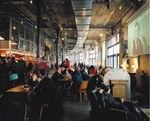Patrick Bouchain: for a cultural, scientific and joint approach towards architecture
Patrick Bouchain was born in 1945 and taught at Camondo School and the Bourges School of Fine Arts before founding the Paris National School of Industrial Creation. His work is essentially culture-related. He is the central figure in event-driven projects such as the Large Wheels spectacle on the Champs-Élysées in the year 2000; he is also the architect of the Annie Fratellini Academy in Saint-Denis, the auditorium designed specially for Mstislav Rostropovitch and Evian musical events, and more recently the renovation of the Bègles municipal swimming pool, registered in the supplement to the historical monuments inventory.
The wooden horse theater for Bartabas has been built on land recovered from the former Aubervilliers fort for which there was a risk of never finding a use and that it might be prohibited to construction, because there had been no viable program for it for several years: "We have submitted a request for a building permit and signed a temporary occupancy agreement with the town. If the town had needed the land, we would have had to take everything down. But the theatre is now surrounded by about 10 other buildings. The area is completely requalified. Forty families are living in it and the building forms part of the history of the commune, perhaps more than others that were designed to be permanent."
The site, place of know-how and exchanges
Patrick Bouchain confirms that he only supervises one site at a time, so that he can maintain close and successful relations with the owner. There is a very large plywood mock-up on site accessible to everyone, that is continuously updated. "The site is an important and experimental moment in itself", says the architect. It is an adventure, a time for discovery and a place for sharing knowledge that it should be possible to use as such. "My sites are open to the public at a very early stage", he says. In order to offer something more than a simple visit, the traditional prefabricated site hut is transformed into a multipurpose room designed to include a small restaurant and armchairs in which professionals, and also councilors, local inhabitants, students and families can hold their meetings and can come for refreshment and information. "All active persons on the site must present some of their specific know-how at least once. For example, an acoustic engineer will hold a conference for local inhabitants to explain what a reduction in decibels means; a plumber will explain how to make a gutter; other competent persons will deal with more global subjects such as sustainable development or the HQE (High Environmental Quality) standard."
Scientific 1%
Patrick Bouchain has initiated the "scientific 1%" for renovation of the Bègles municipal swimming pool. Swimming pool regulations make it necessary to fill the baths with disinfected and disinfecting water to prevent contamination of bathers. This heated water with a high chlorine content produces residues that cannot be filtered. This means that 40 liters of polluted water have to be discharged into the drain every day for each bather, with the consequence of killing surrounding bacteria and reducing the efficiency of treatment plants. Starting from this observation, "we assigned 1% of the global project cost to a study on a scientific problem regarding the regulations, within the framework of sustainable development. This led us into phytoremediation, in other words how a plant can do this depollution work and enable water treatment." After a debate between the town council, the water agency, the technical department, the A’QUIA, University research workers and Bordeaux botanical gardens curator, it was decided to add a sixth lane to the five lanes already planned for Bègles swimming pool. A sixth lane the same width as the others was added at the side of the original five swimming lanes and was filled with aquatic plants. This water is depolluted under the action of plants and is made less toxic, and it is now used for toilet flush tanks in locker rooms and for water supply points for local municipal cleaning.
Communal 1%
The Architect confesses that he has usually included the "communal 1%" in his project specifications since 1999. In Bègles, the objective was to understand what public was concerned by the swimming pool, in other words to verify the demand. Without concentrating on the exclusively sports nature of the facility, Patrick Bouchain oriented his research towards a pool "for everyone". Bringing together health professionals, specialists in anti-exercise gymnastics, associations and also retired persons with skills to be shared, the old 1932 pool was partially transformed into a games area adapted to the older, young children and the handicapped with its wood waves and its paddling pond. Patrick Bouchain, who confirms that in accordance with the "democratic" request, he will not discuss aesthetic considerations and will concentrate on practical needs of the project and concludes: "We were building a swimming pool; the idea was to apply our experience and knowledge to Do Better. Everyone is concerned by the building; this enabled inhabitants to gradually control how their environment changes. And this facility would never have seen the light of day if our project had not been developed as a site for critique in the production of a sports facility."



